We explain the transition from the Francoist dictatorship to democracy in Spain. In addition, we explore the history of democratic governments.

What is Spanish democracy?
The term Spanish democracy refers to the period of Spanish history that began following the death of Francisco Franco in 1975 and continues to the present day. It is generally divided into several stages:
- The transition (1975-1978), i.e. the shift from Franco's dictatorship to a democratic system.
- The constitutional governments of Adolfo Suárez and Leopoldo Calvo Sotelo (1979-1982) of the Union of the Democratic Center party (Unión de Centro Democrático; UCD)
- The governments of Felipe González (1982-1996) of the Spanish Socialist Workers’ Party (Partido Socialista Obrero Español; PSOE)
- the governments of José María Aznar (1996-2004) of the People’s Party (Partido Popular; PP)
- The governments of José Luis Rodríguez Zapatero (2004-2011) of the Spanish Socialist Workers’ Party (PSOE).
- The governments of Mariano Rajoy (2011-2018) of the People’s Party (PP)
- The governments of Pedro Sánchez (2018-present) of the Spanish Socialist Workers’ Party (PSOE) in coalition with United We Can (Unidas Podemos).
Since the transition period, Spain has been a parliamentary monarchy under the Spanish Constitution of 1978.
- See also: Spanish Civil War
Spanish transition to democracy
The political forces of the transition
Following the death of Francisco Franco on November 20, 1975, Juan Carlos I was proclaimed king amidst a political context of great uncertainty. Thus began a complex transition process from a dictatorship to a democratic system.
The political forces of the transition were divided into two main groups: Francoists and opponents.
As regards Francoists, Franco's death exacerbated differences between two factions:
- The "búnker", organized around figures like Blas Piñar, who advocated for the Francoist order.
- The "aperturistas", who were open to the introduction of reforms. Among the latter were veteran politicians from the dictatorship regime who were convinced of the need for change, such as Manuel Fraga or José María de Areilza, as well as young people who were to play an important role in the transition. The key figure in this group was Adolfo Suárez.
The opposition forces were made up of various figures and organizations:
- The forces of the liberal right were very weak and were grouped around figures like Joaquín Ruiz Gimenez and José María Gil Robles or supporters of Juan de Borbón, father of the monarch.
- The Democratic Convergence of Catalonia (Convergencia Democrática de Cataluña), led by Jordi Pujol, stood out among the nationalist forces in Catalonia.
- In the Basque Country, the Basque Nationalist Party (Partido Nacionalista Vasco; PNV) was the major party, and the terrorist organization ETA (Euskadi Ta Askatasuna) became increasingly active.
- The Communist Party of Spain (Partido Comunista de España; PCE) led by Santiago Carrillo, distinguished itself among the left-wing forces.
- The Spanish Socialist Workers’ Party (PSOE) had held a congress in Suresnes (France) in 1974, where a new leadership group centered around Felipe González and Alfonso Guerra had been formed. The People’s Socialist Party (Partido Socialista Popular) of Enrique Tierno Galván was another left-wing force that eventually merged into the Spanish Socialist Workers’ Party (PSOE).
- Communist hegemony was also reflected in the labor union world. The Workers’ Commissions (Comisiones Obreras), linked to the PCE, was the most powerful labor union, while the General Union of Workers (Unión General de Trabajadores; UGT), linked to the PSOE, began to reorganize. The historic National Confederation of Labor (Confederación Nacional del Trabajo; CNT), of anarcho-syndicalist stance, managed to rebuild itself but became a minority party.
Disagreements between the PCE and the PSOE prevented the democratic opposition from forming a single alliance. Consequently, two coalitions emerged: the Democratic Junta (Junta Democrática), dominated by the PCE and with a strong mobilization capacity, and the Democratic Convergence Platform (Plataforma de Convergencia Democrática), among which the PSOE, the PNV, and the UGT were the main forces.
The government of Carlos Arias Navarro
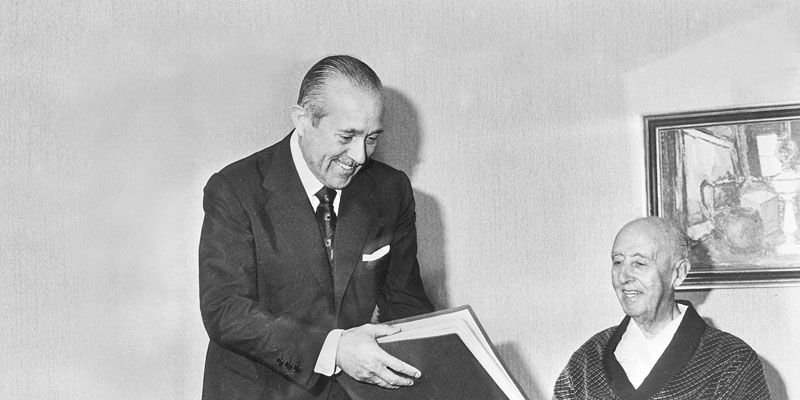
The initial period of the monarchy of Juan Carlos I was characterized by uncertainty. Many suspected that the new monarchy would be a continuation of Francoism without Franco. However, the king surrounded himself with a group of advisors, among them Torcuato Fernández Miranda, who designed a plan for political change.
This reform plan sought to introduce controlled changes that would guarantee the continuation of Francoist civil servants and military, and that would lead to a democratic system based on the existing Francoist laws.
Initially, the king chose to retain Carlos Arias Navarro, who had presided over the executive branch in the final phase of the dictatorship. The government included Manuel Fraga as Minister of the Interior and young figures of the National Movement (Movimiento Nacional), a Francoist organization, such as Adolfo Suárez and Rodolfo Martín Villa.
The Arias Navarro administration failed to implement reforms and responded to social protests with repression. A wave of strikes spread throughout the country in January 1976. The repressive response culminated with the Vitoria incidents in March 1976, when five workers were killed by the police.
That same month, all opposition groups united under the Coordinación Democrática (also known as Platajunta), which intensified protests against the Arias Navarro government. Finally, the king dismissed Arias Navarro in July 1976.
The government of Adolfo Suárez and the Political Reform Act
In July 1976, Adolfo Suárez, a young politician of the National Movement (Movimiento Nacional), was appointed president of the government. Although the new administration was formed by pro-reform ministers, many believed that Suarez was not the right man to lead the process towards democracy.
Shortly afterwards, in September 1976, Suárez presented the draft for the Political Reform Act. This was the legislative embodiment of the dismantling process of Francoism initiated from within the regime itself. Simultaneously, Suárez initiated contact with the democratic opposition.
The most conservative sectors of Francoism, dissatisfied with the political changes and with the terrorist attacks by ETA and GRAPO (Grupos de Resistencia Antifascista Primero de Octubre; First of October Anti-Fascist Resistance Groups), began to plot a military coup against the reform process. In September 1976, Suarez appointed Lieutenant General Manuel Gutierrez Mellado as Deputy Prime Minister, who became a key figure in controlling the coup threat within the army.
Despite the coup conspiracies and the ETA attacks, the awareness that changes were inevitable led Franco's Cortes to approve the Political Reform Act in November 1976.
Opposition advances in 1976 and 1977
Gradually, the opposition began to come out of hiding. In December 1976, the Spanish Socialist Workers' Party (PSOE) held its 27th Congress in Madrid, which was attended by important international leaders. Furthermore, communist leader Santiago Carrillo held a clandestine press conference in Madrid, demanding the legalization of the Communist Party of Spain (PCE). He was arrested on December 22, 1976, and released eight days later.
In December 1976 a popular referendum on the Political Reform Act was conducted. The response was overwhelming: with 77.7% participation rate, 94.1% 94.1% of the votes were in favor.
The opposition, which had initially distrusted Suarez, soon realized that the end of Francoist rule would not occur through what they termed a "democratic break" (with the immediate formation of a provisional government, amnesty, the legalization of all parties, and free elections). Henceforth, a large part of the opposition came to support a reform process that would lead to the establishment of a democratic regime by agreement.
1977 elections
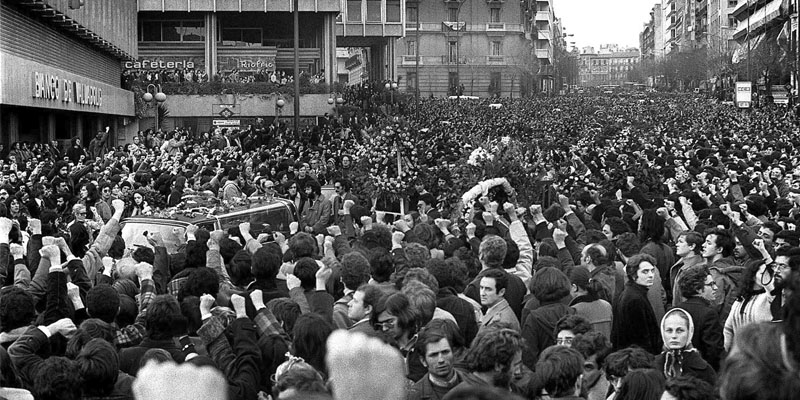
The transition reform process was threatened by two mutually feeding opposing forces: terrorist attacks and coup threats. The situation reached a critical point in January 1977, when to the ETA and GRAPO attacks, the Atocha massacre was added: the murder of five communist lawyers by an extreme right-wing group. This event heightened the coup threat.
The response was a massive and peaceful demonstration in Madrid that showed a widespread willingness to continue the changes without violence.
From then on, Adolfo Suárez introduced measures that facilitated the transition to a democratic regime, such as the legalization of the Communist Party of Spain (PCE) in April 1977 and amnesty for political prisoners. In June 1977, the first democratic elections since the Second Republic were held.
The winning party, with 34.5% of the votes, was the Union of the Democratic Center (UCD), organized by Suárez, which brought together the pro-reform members of Francoism with some moderate sectors of the democratic opposition.
The second most voted party was Felipe González's PSOE with almost 30% of the votes. To the surprise of many, the PSOE took on the hegemony on the left, with the PCE behind with 9.4 %. Jordi Pujol's Convergence and Union (Catalonia) and the PNV (Basque Country) became the principal nationalist forces.
Moncloa Pacts (1977)
Suárez's new government took on the two main challenges of the time: drawing up a Constitution that would structure the new democratic system politically, and confronting ETA terrorism and the coup threat.
This political process took place in a context of a deep economic crisis. The 1973 oil crisis had struck Spain, where unemployment and inflation were soaring. To stabilize the situation, the main political forces signed the Moncloa Pacts (Pactos de la Moncloa) in October 1977, a series of agreements to address the economic crisis.
Spanish Constitution of 1978
The Cortes (Spanish Parliament) formed after the 1977 elections were charged with drafting a new constitution. Seven representatives belonging to the main political parties (UCD, PSOE, PCE, Popular Alliance, and the Catalan and Basque minorities), known as the "fathers of the Constitution" (padres de la Constitución), were given the task.
The Spanish Constitution of 1978 was approved in October and ratified in a referendum in December 1978. Since then, it has been the magna carta of the Spanish State. Its enactment implied the need to call an election according to the new constitutional order.
Constitutional governments of the UCD
The constitutional government of Adolfo Suárez (1979-1981)
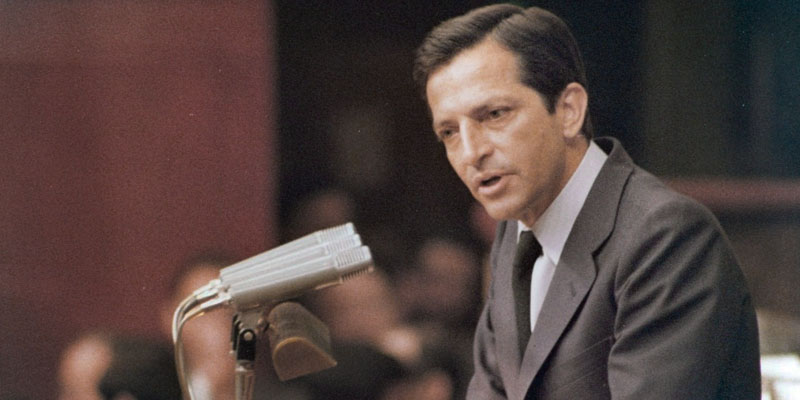
Following the approval of the Constitution, the Cortes (Spanish Parliament) were dissolved, and in the elections that ensued on March 1, 1979, Adolfo Suárez’s UCD (Union of the Democratic Center) emerged victorious once again. However, in the municipal elections (the first democratic municipal elections since the Second Republic), the left took control of the major city councils, thanks to the alliance between the PSOE (Spanish Socialist Workers' Party) and the PCE (Communist Party of Spain).
Despite this alliance, the leader of the PSOE, Felipe González, forced a political and ideological shift within his party following the celebration of its 28th Congress. In September 1979, the PSOE abandoned Marxism as its official ideology, repositioning itself as a moderate left-wing party that could aspire to power in the upcoming elections.
1979 marked the beginning of a period of political decay that led to a thwarted coup d'état in 1981. Several factors contributed to this political crisis:
- ETA's growing terrorist campaign, which claimed 77 lives in 1979 and 95 in 1980, marking the two deadliest years in the history of the organization.
- Growing unrest within far-right military circles, which initiated discussions for orchestrating a coup.
- The end of a political consensus, marked by the onset of a rigorous opposition campaign by the PSOE.
- The ratification of the Statutes of Autonomy for the Basque Country and Catalonia at the end of 1979, and the subsequent regional elections, which gave a majority to the nationalist forces: Jordi Pujol's Convergence and Union (Catalonia) and the PNV (Basque Country).
- The internal crisis within the UCD, where disagreements and internal criticisms in a party that had been born artificially, progressively weakened Suárez's position.
All these factors precipitated Suarez's resignation on January 29, 1981. Another UCD leader, Leopoldo Calvo Sotelo, was designated presidential candidate. Following his failure to secure a majority in the initial voting, a second round was scheduled for February 23 to confirm his appointment.
On that day, there was a failed coup d'état attempt, led by military figures such as Jaime Milans del Bosch and Alfonso Armada. A faction of the Civil Guard led by Lieutenant Colonel Antonio Tejero stormed the Cortes, holding the government and legislative body hostage. The coup failed due to the intervention of King Juan Carlos I, enabling Calvo Sotelo to succeed Suárez at the head of the government.
The government of Leopoldo Calvo Sotelo (1981-1982)
Leopoldo Calvo Sotelo governed for only a year and a half. This period was marked by the disintegration of his own party, the approval of the Divorce Law amidst significant opposition from the Church, and the scandal unleashed by the mass poisoning caused by contaminated rapeseed oil.
In May 1982, with the opposition of the left-wing parties, Spain joined the North Atlantic Treaty Organization (NATO). The PSOE promised a popular referendum on this membership if it became government.
In October 1982, Calvo Sotelo called elections. The PSOE won a landslide victory, with over ten million votes, securing an absolute majority in the Congress of Deputies. The UCD lagged far behind, and the main right-wing party transitioned to the Popular Alliance led by Manuel Fraga.
Democratic governments since 1982
The governments of Felipe González (1982-1996)
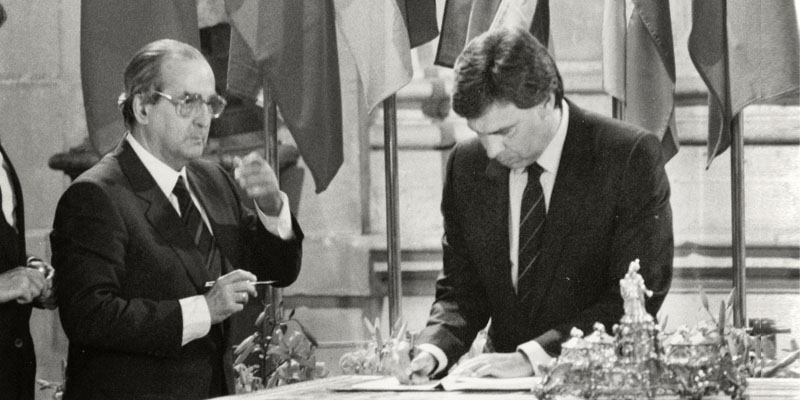
In the first socialist term (1982-1986), the government led by Felipe González faced a difficult economic situation. The socialist cabinet approved a stringent economic stabilization plan which involved an industrial restructuring process as well as the closure of many industries, to the bewilderment of labor unions.
Furthermore, the socialist government had to counter ETA's terrorist campaign and reform the Army to eliminate the coup d'état threat. This reform was a significant success of the cabinet.
Other measures included the approval of the university reform (LODE), which established free and compulsory education until the age of sixteen, and a partial decriminalization of abortion.
Simultaneously, Spain joined the European Economic Community (EEC) on January 1, 1986. As a consequence, Felipe González altered his stance on NATO: the initial refusal to join the western military alliance turned into support. González honored his promise to hold a referendum, advocating for a yes vote to remain in NATO. The triumph of the stance defended by González consolidated his position as a political leader.
During these years, the map of Spain's autonomous communities was finally drawn up with the approval of the several statutes of autonomy.
In 1986, the PSOE secured another electoral victory with an absolute majority. The second socialist term (1986-1989) witnessed substantial economic development that lasted until 1992. This period saw an ambitious public infrastructure investment policy, favored by the funds transfer from the EEC.
Educational, health, and pension services significantly expanded, financed through a relatively progressive tax system. For the first time it was possible to speak of a "welfare state" in Spain.
However, economic growth and liberalization policies brought about an increase in the wealth gap among different social groups. Consequently, the Workers’ Commissions (Comisiones Obreras) and UGT went on a general strike on December 14, 1988. The country came to a standstill, compelling Felipe González to negotiate the partial withdrawal of his liberalizing program.
In the 1989 elections, the PSOE retained power with an absolute majority. During the third PSOE administration (1989-1993), Spain hosted two international events in 1992 – the Barcelona Olympic Games and the Seville Expo, projecting a modern image starkly different from Franco's dictatorial era.
However, the global recession that started in the early 1990s severely impacted Spain, triggering inflation and unemployment, with the latter reaching a staggering three million.
In the 1993 elections, PSOE emerged victorious again, but this time without an absolute majority, requiring the parliamentary support of Jordi Pujol's Convergence and Union party. Meanwhile, the right-wing forces reorganized under the Popular Party (PP), led by José María Aznar since 1989.
During Felipe González's fourth term (1993-1996), the economic crisis, corruption scandals, and an aggressive opposition campaign precipitated early elections in 1996.
The governments of José María Aznar (1996-2004)

José María Aznar of the Popular Party (PP) failed to achieve an absolute majority, and was forced to make alliances with the nationalist minorities to secure his position. This rightward shift was confirmed with PP's victories in regional and municipal elections. The socialist cycle under the leadership of Felipe González was over.
Aznar focused his efforts on implementing orthodox economic policies aimed at reducing public deficit and revitalizing private economic activity. The main objective was to meet the convergence criteria established in the Maastricht Treaty of 1992 (restrictions on inflation rate, public debt, and fiscal deficit), which, once met, would allow Spain to adopt the new European currency: the euro.
Economic activity revived, unemployment fell, and economic recovery enabled Spain to participate in the introduction of the euro in 1999.
In addition, Aznar's administration, with the socialist opposition's support, adopted a hardline approach against ETA following the public outcry over the assassination of councilman Miguel Ángel Blanco in 1997. All Basque nationalist forces, from the PNV to ETA, agreed on the Lizarra-Estella Pact in 1998 to advance towards independence. A few days later, ETA announced an indefinite and unconditional ceasefire.
However, the negotiations between Aznar's government and ETA proved fruitless, and a year later, ETA resumed its armed activities. As a result, Aznar intensified his confrontation policy against Basque nationalism in all its forms.
The elections held in 2000 marked the peak of the PP and Aznar’s influence. The new century began with a resounding majority for the PP in the Cortes. Aznar presided over the Spanish government until April 2004.
Towards the end of 2001, Aznar's government decided to send troops to Afghanistan, following the U.S-led invasion in the aftermath of the September 11, 2001 attacks. In 2003, Spain also joined the coalition that invaded Iraq, prompting massive protest demonstrations.
On March 11, 2004, Madrid witnessed a series of terrorist attacks perpetrated by jihadist militants, causing in 193 deaths. Three days later, general elections were held, and the PSOE won, ushering José Luis Rodríguez Zapatero into power.
The governments of José Luis Rodríguez Zapatero (2004-2011)
The first measure adopted by Rodríguez Zapatero was the withdrawal of Spanish troops from Iraq. Other policies during his first term (2004-2008) were the same-sex marriage law, the Organic Law of Education, and the Historical Memory Law.
In 2006, Rodríguez Zapatero agreed to a new statute of autonomy for Catalonia, recognizing Catalonia as a "nation". He also initiated talks with ETA, who announced a permanent ceasefire in March 2006 but resumed armed activities in December that same year. The ceasefire actually became effective in 2011, with ETA announcing its dissolution in 2018.
Rodríguez Zapatero's second term (2008-2011) was marred by the economic crisis that unfolded in 2008 due to the real estate and banking sectors' collapse, resulting in high unemployment rates and evictions. The government's measures exacerbated the fiscal deficit without successfully addressing the crisis or reducing unemployment.
The increase in public debt led credit agencies to begin demanding austerity measures from the Spanish government in 2010. On May 15, 2011, the " Indignados" movement (also known as 15-M) was born: self-organized groups that peacefully protested against the dominant parties and major banks.
In November 2011, early elections were held, resulting in a victory for the PP, which put Mariano Rajoy in the presidency.
The governments of Mariano Rajoy (2011-2018)
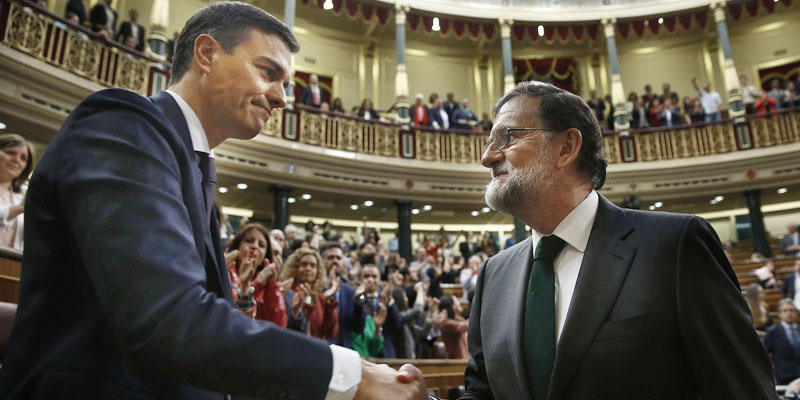
Mariano Rajoy carried out a policy of reductions in social spending, labor reforms, and tax increases to reduce the fiscal deficit, which provoked strikes and demonstrations. He also secured a partial bailout from the European Union and the International Monetary Fund (IMF), which helped stabilize the economy, but unemployment remained high.
During these years, separatist movements in Catalonia and the Basque Country intensified their demands for autonomy. Moreover, in 2014, the left-wing party Podemos (We can) was established, which began to gain prominence through its critiques of Rajoy's austerity policies. In 2014, King Juan Carlos I abdicated in favor of his son, Felipe VI.
In the 2015 elections, the PP (People’s Party) emerged victorious but lost the parliamentary majority, while the PSOE (Spanish Socialist Workers' Party) finished second but lost many votes compared to previous elections. Podemos and the center-right party Ciudadanos (Citizens) captured many of those votes.
The new situation meant that the PP was unable to form a government, prompting new elections with similar outcomes. Eventually, in October 2016, the abstention of Socialism in the confidence vote to Rajoy allowed him to start his second term as president of the Government.
In October 2017, a referendum for the independence of Catalonia proposed by the Catalan government ended in violence, when the police suppressed the voting, deemed illegal by the Spanish government. Rajoy invoked an article of the Spanish Constitution, intervened in Catalonia, and called for new elections to be held in December 2017.
Despite his firm stance on the Catalan issue, the weakness of Rajoy's government, coupled with corruption scandals from previous years, enabled the leader of the PSOE, Pedro Sánchez, to present a no-confidence motion against the president.
This motion of no confidence was voted in favor by Unidos Podemos (United We Can) and the Catalan and Basque nationalist parties on June 1, 2018. Rajoy was forced to leave the government.
The governments of Pedro Sánchez (2018-present)
Pedro Sánchez came to power on June 2, 2018. In the April 2019 elections, the PSOE emerged as the party with the highest number of votes but did not obtain the sufficient number of deputies to form a government.
In November 2019, new elections were held, and the PSOE agreed to form a coalition government with Unidas Podemos. Pedro Sánchez started his second term in January 2020.
Explore next:
References
- Carr, R. et al. (2022). Spain. Encyclopedia Britannica. https://www.britannica.com/
- Casanova, J. & Gil, C. (2012). Breve historia de España en el siglo XX. Ariel.
- Pinilla García, A. (2021). La Transición en España. España en transición. Alianza.
- Powell, C. (2001). España en democracia 1975-2000. Plaza & Janés.
Was this information useful to you?
Yes NoThank you for visiting us :)